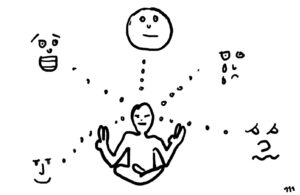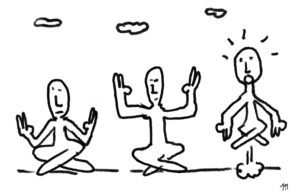Is 10 minutes of meditation a day enough ? Welcome to the world of meditation.
It is an ancient practice that has gained significant popularity in recent years.
Through daily meditation, individuals can tap into the transformative power of their minds and bodies.
But how much time is enough to reap the benefits?
In this article, we will explore the question of whether 10 minutes of meditation a day is sufficient for a meaningful practice.
Key takeaways
![]() 10 minutes of meditation a day can have a profound impact on one’s life.
10 minutes of meditation a day can have a profound impact on one’s life.
![]() Even a short daily practice can yield significant benefits.
Even a short daily practice can yield significant benefits.
![]() Recognizing the importance of prioritizing one’s well-being.
Recognizing the importance of prioritizing one’s well-being.
Understanding the Benefits of Meditation

Meditation offers a multitude of benefits for our overall well-being. Let’s explore these benefits in detail.
- Discovering the Physical Benefits
Reduced stress and anxiety levels: Regular meditation has been shown to decrease the production of stress hormones, promoting a sense of calm and relaxation.
Improved sleep quality: By calming the mind and relaxing the body, meditation can help improve the quality of sleep, leading to increased vitality and energy.
Enhanced focus and concentration: Through mindfulness practices, meditation can sharpen our attention and improve our ability to concentrate on tasks.
- Exploring the Mental and Emotional Benefits
Increased self-awareness and mindfulness: Meditation cultivates a deep sense of self-awareness, allowing individuals to observe their thoughts and emotions without judgment.
Cultivating a sense of inner peace and calm: Regular meditation practice can bring a sense of tranquility and harmony, helping individuals navigate the challenges of daily life with greater ease.
Developing resilience and emotional well-being: Meditation teaches individuals to regulate their emotions, enhancing emotional intelligence and promoting a greater sense of well-being.
- Unveiling the Spiritual Benefits
Deepening connection with oneself and others: Meditation encourages individuals to connect with their true essence, fostering a deeper understanding of oneself and fostering meaningful relationships with others.
Tapping into intuition and higher consciousness: Through meditation, individuals can access their intuition and tap into a higher state of consciousness, gaining insights and guidance.
Nurturing a sense of purpose and meaning in life: By cultivating a regular meditation practice, individuals can discover a deeper sense of purpose and meaning, guiding them on their life journey.
Stay tuned for the next section, where we will explore the science behind meditation and its impact on the brain.”
II. Understanding the Benefits of Meditation
Discovering the physical benefits

- Reduced stress and anxiety levels
- Meditation has been shown to decrease cortisol, the stress hormone, leading to a reduction in stress and anxiety levels.
- The practice of meditation activates the parasympathetic nervous system, promoting relaxation and a sense of calm.
- Studies have demonstrated that regular meditation can lower blood pressure and heart rate, contributing to overall cardiovascular health.
| Duration | Benefits | Considerations |
|---|---|---|
| 10 Minutes | Reduces immediate stress, Increases focus and attention, Boosts mood | May be sufficient for beginners, Ideal for busy schedules, Consistency is key |
| 20 Minutes | Deepens relaxation, Enhances mindfulness, Strengthens cognitive benefits | Requires more commitment, Can yield more significant long-term benefits, May be more effective for stress management |
| 30+ Minutes | Potentially transformative impact on mental state, Improves emotional regulation, May enhance self-awareness and insight | Requires dedicated practice, Not always practical for daily routine, Recommended for advanced practitioners |
- Improved sleep quality
- Research suggests that meditation can help improve sleep quality by calming the mind and reducing racing thoughts.
- Practicing meditation before bedtime can aid in falling asleep faster and experiencing deeper, more restful sleep.
- By promoting relaxation and reducing stress, meditation can alleviate insomnia and sleep disturbances.
- Enhanced focus and concentration
- Regular meditation practice has been linked to improved focus and concentration abilities.
- The practice of mindfulness meditation trains the mind to stay present and focused on the task at hand.
- Studies have shown that meditation can increase gray matter density in brain regions associated with attention and concentration.
Exploring the mental and emotional benefits
- Increased self-awareness and mindfulness
- Meditation cultivates self-awareness, allowing individuals to observe their thoughts and emotions without judgment.
- By developing mindfulness, individuals can better understand their patterns of thinking and reacting, leading to personal growth.
- Mindfulness meditation has been shown to reduce rumination, a common factor in depression and anxiety.
- Cultivating a sense of inner peace and calm
- Regular meditation practice can help individuals experience a deep sense of inner peace and tranquility.
- By training the mind to let go of negative thoughts and emotions, meditation promotes emotional well-being.
- Mindfulness meditation techniques, such as loving-kindness meditation, foster feelings of compassion and contentment.
- Developing resilience and emotional well-being
- Meditation strengthens emotional resilience, allowing individuals to bounce back from adversity.
- The practice of meditation helps individuals regulate their emotions and respond to challenges with equanimity.
- Studies have shown that meditation can reduce symptoms of depression and improve overall psychological well-being.
Unveiling the spiritual benefits

- Deepening connection with oneself and others
- Meditation can deepen the connection with oneself by fostering self-reflection and self-discovery.
- Through regular practice, individuals can develop a greater understanding of their values and purpose in life.
- Meditation also promotes empathy and compassion, enhancing relationships and fostering a sense of interconnectedness.
- Tapping into intuition and higher consciousness
- Regular meditation can help individuals tap into their intuition and access a deeper level of wisdom.
- By quieting the mind and cultivating inner stillness, meditation opens the door to insights and creative inspiration.
- Some individuals report experiencing a sense of connection to a higher power or universal consciousness through meditation.
- Nurturing a sense of purpose and meaning in life
- Meditation can provide individuals with a greater sense of purpose and meaning in life.
- By aligning with one’s values and inner guidance, meditation helps individuals find clarity and direction.
- Regular meditation practice can lead to a greater sense of fulfillment and a deeper understanding of one’s life purpose.
In conclusion, meditation offers a wide range of benefits for both the mind and body. From reducing stress and anxiety to enhancing focus and concentration, meditation has the potential to transform one’s well-being. By exploring the physical, mental, emotional, and spiritual benefits of meditation, individuals can embark on a journey of self-discovery and personal growth. Embracing the transformative power of just 10 minutes of meditation a day can lead to a more balanced, peaceful, and fulfilling life.”
III. Exploring the Science behind Meditation
The practice of meditation has long been revered for its profound effects on the mind and body. Through extensive scientific research, we have gained a deeper understanding of the mechanisms behind these benefits. In this section, we will explore the intricate science behind meditation and how it positively impacts various aspects of our well-being.
The impact of meditation on the brain
- Neuroplasticity and rewiring of neural pathwaysMeditation has been shown to induce neuroplasticity, the brain’s ability to reorganize itself by forming new neural connections. This process allows for the rewiring of neural pathways, leading to improved cognitive functions and emotional regulation. Studies have shown that regular meditation practice can enhance memory, attention, and learning abilities.
- Activation of the prefrontal cortex and improved decision makingThe prefrontal cortex, responsible for executive functions such as decision making and problem-solving, is strengthened through meditation. By activating this region of the brain, individuals experience improved cognitive flexibility, better judgment, and enhanced self-control. This can lead to more informed and thoughtful decision making in various aspects of life.
- Regulation of the amygdala and emotional responsesThe amygdala, known as the center for emotional processing in the brain, plays a crucial role in our response to stress and fear. Through meditation, the amygdala’s activity is regulated, resulting in reduced reactivity to emotional stimuli and a heightened ability to maintain emotional balance. This can lead to a greater sense of calm and resilience in the face of challenges.
The role of meditation in reducing stress hormones
- Lowering cortisol levels : Cortisol, often referred to as the “”stress hormone,”” is released in response to perceived threats or stressors. Prolonged exposure to high levels of cortisol can have detrimental effects on our physical and mental well-being. Meditation has been found to significantly lower cortisol levels, promoting a state of relaxation and reducing the negative impact of chronic stress.
- Increasing the production of serotonin and dopamine : Serotonin and dopamine are neurotransmitters associated with feelings of happiness, pleasure, and overall well-being. Meditation has been shown to increase the production and release of these neurotransmitters, leading to improved mood and a greater sense of contentment. This can contribute to a more positive outlook on life and increased emotional well-being.
- Balancing the autonomic nervous system : The autonomic nervous system is responsible for regulating essential bodily functions, such as heart rate, blood pressure, and digestion. Meditation helps balance the autonomic nervous system by activating the parasympathetic branch, also known as the “”rest and digest“” response. This induces a state of relaxation and promotes overall physical and mental equilibrium.
Incorporating meditation into our daily lives has numerous scientifically proven benefits. By understanding the impact of meditation on the brain and its role in reducing stress hormones, we can harness its transformative power to enhance our well-being.
Now, let’s delve into the debunking of the myth of time and explore how even short meditation sessions can yield significant benefits.
IV. Debunking the Myth of Time
Understanding the concept of time in meditation

In the world of meditation, time is often a topic of concern.
Many individuals question whether they have enough time in their busy schedules to dedicate to a meditation practice.
However, it is important to understand that in meditation, the focus should be on quality over quantity.
When it comes to meditation, it is not about the length of time spent, but rather the depth of presence and intention.
It is possible to experience profound benefits from just a few minutes of daily meditation. The key is to make the most of the time you have and to cultivate a consistent practice.
To better understand the concept of time in meditation, let’s explore three important points:
- Focusing on quality over quantity
In meditation, it is not about how long you meditate, but rather how present and focused you are during that time.
A few minutes of deep, focused meditation can be more beneficial than a longer period of distracted practice. By prioritizing quality over quantity, you can maximize the benefits of your meditation practice.
- The power of consistency and regularity
Consistency is key when it comes to meditation.
By establishing a daily meditation routine, even if it is just for a few minutes, you create a habit that becomes easier to maintain over time.
The regularity of your practice allows you to deepen your meditation skills and experience the cumulative benefits it offers.
- Incorporating mindfulness into daily activities
Meditation doesn’t have to be limited to a designated time and space. It can be integrated into your daily activities, allowing you to infuse moments of mindfulness throughout your day.
Whether it’s mindful breathing while waiting in line or practicing gratitude during a meal, these small acts of mindfulness can have a profound impact on your overall well-being.
Exploring different meditation techniques for time efficiency
Finding the right meditation technique can help you make the most of your limited time. Here are three techniques that are known for their time efficiency:
- Mindful breathing exercises
Focusing on your breath is a simple yet powerful way to cultivate mindfulness. By paying attention to each inhale and exhale, you bring yourself into the present moment. This technique can be practiced anywhere, anytime, making it ideal for busy individuals.
- Guided visualization and imagery
Guided visualization involves creating vivid mental images that evoke a sense of calm and relaxation.
By following along with a guided meditation recording or app, you can quickly enter a meditative state and experience its benefits. This technique allows you to tap into your imagination and harness its transformative power.
- Mantra repetition and chanting
Mantras are sacred words or phrases that are repeated silently or aloud during meditation. By focusing on the sound and vibration of the mantra, you can quiet the mind and cultivate a sense of inner peace.
Chanting mantras can evoke a deep sense of connection and spirituality, making it a powerful practice for those with limited time.
Integrate what you love
Incorporating these techniques into your daily routine can help you make the most of your meditation practice, even if you only have a few minutes to spare.
In conclusion, the myth that longer meditation sessions are always better is debunked. It is not about the amount of time spent, but rather the quality of presence and intention.
By understanding the concept of time in meditation and exploring efficient techniques, you can maximize the benefits of your practice in just a few minutes a day.
So, let go of the pressure to meditate for hours on end, and instead focus on finding what works best for you and your unique lifestyle. Embrace the power of short but focused meditation sessions and witness the transformative effects it can have on your well-being.
V. Setting Realistic Expectations
Embracing the beginner’s mind in meditation
- Accepting the ebbs and flows of the practice
- Meditation is not a linear journey; it will have ups and downs.
- Embrace the natural fluctuations in your meditation experience.
- Understand that some days may feel more challenging than others.
- Letting go of perfection and judgment
- Release the need to achieve a certain level of perfection in meditation.
- Avoid judging yourself or your progress during meditation.
- Instead, focus on the process and the growth you are experiencing.
- Cultivating patience and self-compassion
- Patience is key in meditation; progress takes time.
- Be gentle with yourself and show self-compassion throughout the practice.
- Understand that meditation is a journey of self-discovery and growth.
Recognizing the individuality of meditation experiences
- Every person is unique
- Each individual has their own unique experiences during meditation.
- Your meditation journey will be different from others’.
- Embrace your individuality and honor your own path.
- Honoring personal preferences and needs
- Explore different meditation techniques and find what resonates with you.
- Consider your preferences in terms of time, environment, and style.
- Customize your meditation practice to suit your specific needs.
- Trusting the process and embracing the journey
- Trust in the transformative power of meditation.
- Embrace the journey, even when it feels challenging or uncertain.
- Have faith in the process and the positive impact it can have on your life.
The Story of Sarah
Sarah, a busy professional, initially struggled with meditation. She had high expectations and felt frustrated whenever her mind wandered. However, she soon realized that meditation is a practice, not a destination.
She learned to accept the natural ebbs and flows, understanding that some days would be easier than others. Sarah let go of the need for perfection and embraced self-compassion, reminding herself that progress takes time.
As she continued her meditation journey, she discovered what worked best for her, incorporating calming visualizations and affirmations. Sarah trusted the process and found that meditation brought her a sense of inner peace and clarity amidst her hectic lifestyle.
“I used to approach meditation with rigid expectations, thinking I had to achieve a certain level of stillness and concentration. But once I let go of those expectations and started embracing the flow of my practice, everything changed. Meditation became a journey of self-discovery and personal growth. I learned to be patient with myself and to honor my unique experiences. Now, I look forward to my daily meditation sessions as a time to connect with myself and find inner peace.” – Emily, meditation enthusiast.
Remember, each person’s meditation journey is unique, and it’s important to set realistic expectations. Embrace the beginner’s mind, let go of perfection, and cultivate patience and self-compassion. Recognize your individuality and trust the process. Through meditation, you can embark on a transformative journey towards self-awareness, inner peace, and mindfulness.”
VI. Finding Your Sacred Space

Creating a physical space for meditation
- Choosing a quiet and peaceful environment
When it comes to finding your sacred space for meditation, it is crucial to choose a location that is free from distractions and noise. Opt for a quiet room in your home or seek out a serene outdoor setting where you can connect with nature. By selecting a peaceful environment, you can create a space that allows for deep relaxation and focus.
- Incorporating elements of nature and serenity
To enhance your meditation experience, consider incorporating elements of nature and serenity into your sacred space. This can be as simple as placing potted plants or flowers in the room, or using natural materials such as bamboo or wood for your meditation cushion or mat. These natural elements can help create a calming atmosphere and promote a sense of tranquility.
- Enhancing the ambiance with candles or essential oils
To further enhance the ambiance of your meditation space, you can use candles or essential oils. Lighting a scented candle can add a soft and gentle glow, creating a soothing atmosphere.
Additionally, using essential oils, such as lavender or frankincense, can help promote relaxation and create a calming aroma in the room. Diffusing these oils or using them in a massage oil can help create a serene environment for your meditation practice.
Cultivating an inner sanctuary for meditation
- Creating a mental sanctuary with visualization
In addition to creating a physical space, it is important to cultivate an inner sanctuary for your meditation practice.
This can be done through visualization techniques. Close your eyes and imagine a place that brings you joy and tranquility.
It could be a beach, a meadow, or a peaceful garden. Use your senses to fully immerse yourself in this mental sanctuary, picturing the colors, smells, and sounds that create a sense of peace and calm.
- Tapping into the power of affirmations and intentions
Another way to create an inner sanctuary is by utilizing affirmations and intentions.
Affirmations are positive statements that help shift your mindset and cultivate a sense of peace and positivity.
For example, you can repeat affirmations such as “I am calm and centered” or “I am worthy of inner peace.” Setting intentions before your meditation practice can also help guide your focus and energy. Intention setting involves stating your goals and aspirations for your meditation, such as “I intend to let go of stress and find inner stillness.”
Establishing a daily ritual to enhance the experience
To fully embrace your meditation practice, it can be beneficial to establish a daily ritual that enhances the experience.
This can include rituals such as lighting a candle or incense before you begin, practicing deep breathing exercises to calm the mind and body, or setting a specific time each day for your meditation practice.
By incorporating these rituals, you create a sense of sacredness and commitment to your meditation practice, making it more meaningful and impactful.
By creating both a physical and mental sanctuary for your meditation practice, you set the stage for a deeply transformative experience. Remember, your sacred space is unique to you, so feel free to personalize it with elements that resonate with your individual preferences and needs.
Physical Space for Meditation:
- Quiet and peaceful environment
- Elements of nature and serenity
- Candles or essential oils for ambiance
Mental Sanctuary for Meditation:
- Creating a mental sanctuary with visualization
- Tapping into the power of affirmations and intentions
- Establishing a daily ritual to enhance the experience”
VII. Overcoming Common Challenges
Dealing with a wandering mind
- The mind’s tendency to wander is a common challenge in meditation, but with practice, it can be managed effectively.
- Acknowledging the presence of thoughts without judgment is key.
- Refocusing attention on the present moment helps bring the mind back to the meditation practice.
- Guided meditation apps or calming music can aid in maintaining focus during meditation.
Managing physical discomfort during meditation
- Some individuals may experience physical discomfort while meditating, but there are strategies to alleviate it.
- Exploring different sitting positions or using props, such as cushions or meditation benches, can help find a comfortable posture.
- Incorporating gentle stretches or practicing yoga before meditation can release tension in the body.
- Body scan meditation, which involves bringing attention to different parts of the body, can promote relaxation and alleviate physical discomfort.
VIII. Maximizing the Benefits of 10-Minute Meditations
Incorporating mindfulness into everyday life
- Mindfulness is not limited to the time spent in formal meditation; it can be integrated into daily activities.
- Mindful eating allows for a heightened sensory experience, savoring each bite and being fully present during meals.
- Mindful walking in nature promotes grounding and awareness of the surroundings.
- Mindful listening in conversations enhances connection by fully engaging with the speaker and being present in the moment.
Building a meditation habit for long-term benefits
- Developing a consistent meditation practice is essential for reaping long-term benefits.
- Setting achievable goals, such as starting with 10 minutes a day and gradually increasing the duration, is a vital strategy.
- Establishing a consistent meditation schedule, preferably at the same time each day, helps cultivate a habit.
- Seeking support through meditation communities or classes provides guidance and a sense of community.
IX. Personal Stories and Testimonials
Real-life experiences of individuals practicing 10-minute daily meditation
- The transformative power of 10 minutes of daily meditation is evident in real-life stories.
- One individual shared their journey of overcoming stress and finding inner peace, which has had a profound impact on their overall well-being.
- Another person found that practicing meditation for 10 minutes a day significantly enhanced their focus and productivity in daily life.
- A third individual expressed how incorporating 10 minutes of meditation into their routine helped cultivate a sense of gratitude and overall well-being.
Conclusion
In conclusion, this essay has explored the world of meditation and the benefits it offers. It has discussed the physical, mental, emotional, and spiritual advantages of practicing meditation.
Additionally, it has delved into the scientific evidence behind meditation, highlighting its impact on the brain and stress hormones.
The essay has also debunked the myth of time, emphasizing the importance of quality and consistency in meditation practice. Furthermore, it has emphasized the significance of setting realistic expectations and recognizing the individuality of meditation experiences.
The essay has provided guidance on creating a sacred space for meditation and overcoming common challenges that may arise.
It has also emphasized the potential of 10-minute meditations and how they can be incorporated into everyday life for maximum benefits. Finally, the essay has shared personal stories and testimonials to inspire readers to embark on their own meditation journey, encouraging self-care and mindfulness.
FAQ
- Is 10 minutes of meditation enough?
While the ideal meditation duration may vary for each individual, 10 minutes of meditation can still provide significant benefits. It can help reduce stress, improve focus, cultivate self-awareness, and foster a sense of peace and calm. It is important to remember that consistency and regularity are key, so starting with 10 minutes a day can be a great way to establish a meditation habit. - What are some different meditation techniques for time efficiency?
There are various meditation techniques that can be practiced within a shorter timeframe for time efficiency. Some examples include mindful breathing exercises, guided visualization and imagery, and mantra repetition or chanting. These techniques can help individuals achieve a state of mindfulness and relaxation in a shorter period. - How can I overcome a wandering mind during meditation?
It is common for the mind to wander during meditation. When this happens, it is important to acknowledge the thoughts without judgment and gently refocus attention on the present moment. Utilizing guided meditation apps or music can also assist in maintaining focus and reducing distractions.
FAQ
- What can I do to manage physical discomfort during meditation?
Physical discomfort during meditation can be addressed by exploring different sitting positions or using props to support the body. Incorporating gentle stretches or yoga before meditation can also help alleviate any physical tension. Additionally, practicing body scan meditation, where attention is directed to each part of the body for relaxation, can be beneficial. - How can I incorporate mindfulness into everyday life?
Mindfulness can be integrated into daily life through various practices such as mindful eating, mindful walking in nature, and mindful listening in conversations. These activities promote heightened sensory experiences, grounding, and deeper connections with oneself and the surrounding environment. - How can I build a meditation habit?
Building a meditation habit requires setting achievable goals and tracking progress. Start with a realistic meditation schedule and gradually increase the duration or frequency over time. Seeking support through meditation communities or classes can also provide guidance and accountability in establishing a consistent meditation practice. - Are there any resources or communities available for meditation support?
Yes, there are numerous resources and communities available for meditation support. Online platforms offer guided meditation apps, websites, and forums where individuals can access guided meditations, learn new techniques, and connect with fellow meditators. Additionally, local meditation centers and classes provide opportunities for in-person guidance and community support.
Overall, by embracing the transformative power of just 10 minutes of meditation a day, individuals can embark on a journey towards self-care, mindfulness, and a deeper sense of well-being. It is our hope that this essay has inspired readers to explore the world of meditation and discover the multitude of benefits it has to offer.